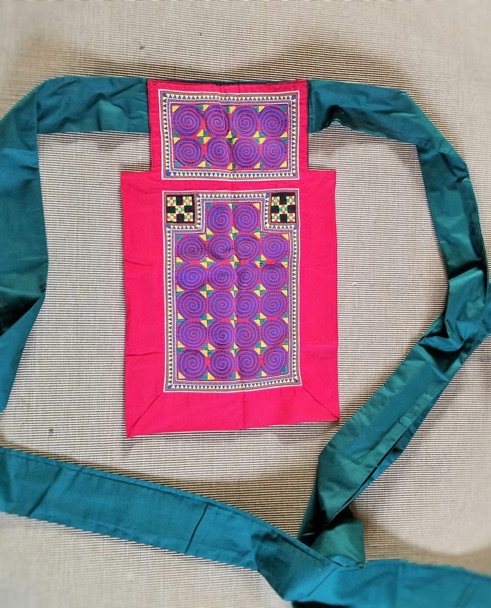
This Hmong cloth baby carrier was hand-stitched in Thailand around 1987, and its history helps tell part of the story of the Hmong community in this state. When the Pathet Lao communist forces took over the Laotian government after the fall of Saigon in 1975, many in the Hmong community fled to Thailand seeking refuge. A young woman named Kia Vang crafted the carrier inside a refugee camp located in Loei province to transport her unborn child to Oshkosh, Wisconsin after the Vietnam War. The Vang family have lived in Oshkosh for thirty years.
The embroidery and colored cloth in this baby carrier tell a story. The stark contrasts of color indicate a period of time as well as geographic region. The vibrant colors in this carrier indicate its production after the War as well as its Hmong origin based on the type of designs used. Kia was born in a village near Hati, Laos, a region in the North which is indicative in the color use and design of the carrier. The Hmong community used strong colors hues before the Vietnam War, but switched to more subdued colors afterwards, catering towards the Western market in order to sell more cloth goods abroad.
According to Vang’s husband, Txerthoj, this garment, if worked on daily, would take around fifteen days to finish. Traditionally in Hmong culture, textile making is a social process, and when women tell stories of the day while assisting others in stitching or choosing patterns and colors.
This baby carrier tells the story of the Vang family’s journey to Oshkosh after the Vietnam War. Hundreds of thousands of Southeast Asians were displaced during the War, and in deference to those that experienced the aftermath of arguably one the most violent wars in U.S. history, Gerald Ford passed the Indochina Migration and Refugee Assistant Act in 1975, allowing refugees to resettle in four states within the United States: California, Wisconsin, Michigan and Minnesota. There are nearly 50,000 Hmong-Americans living in Wisconsin.
Written by Caitlin Leahy, October 2018.
SOURCES
Judith A. Lewis, Hmong Visual, Oral, and Social Design: Innovation within a Frame of the Familiar. Thesis. California State University, Sacramento, 1993.
“Interview with Txerthoj.” Personal interview. 22 April 2016.
William Ruefle, Willliam H. Ross, and Diane Mandell. “Attitudes toward Southeast Asian Immigrants in a Wisconsin Community.” The International Migration Review 26.3 (1992): 877-98.
READERS RESPOND
“It is so great to see some Hmong needlework other than the amazing narrative pictures of travels to the United States, usually on the blue background. I love these geometric patterns!” −Sara



